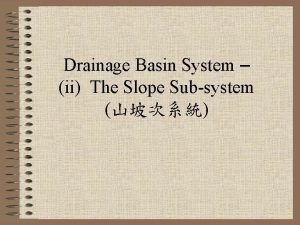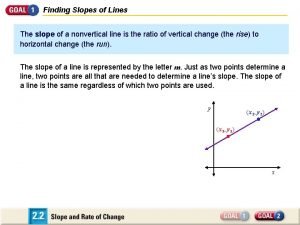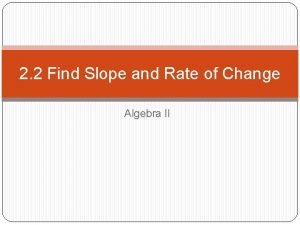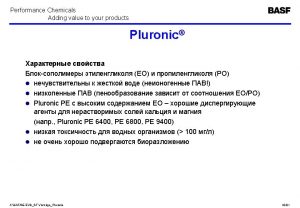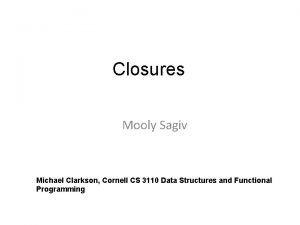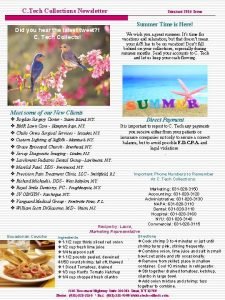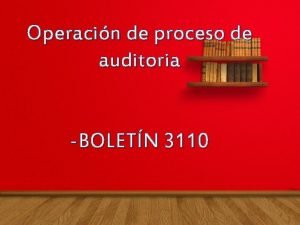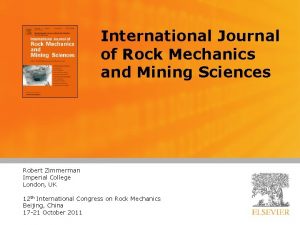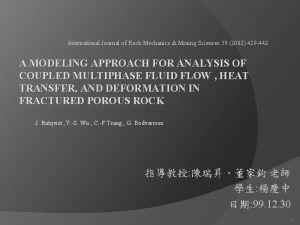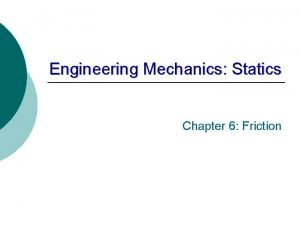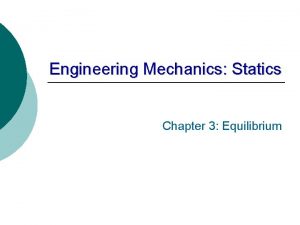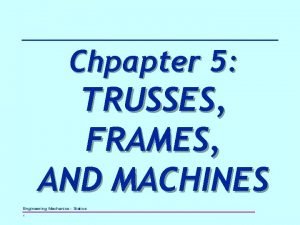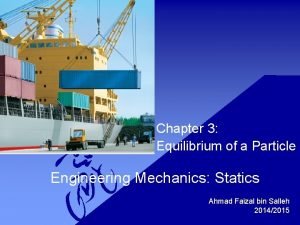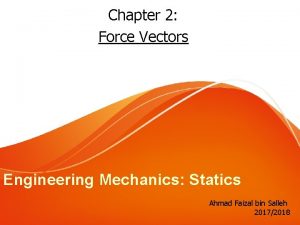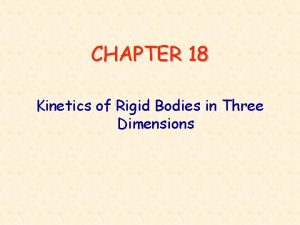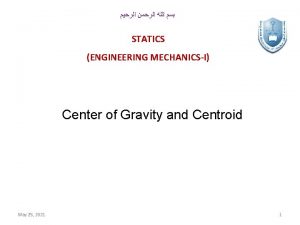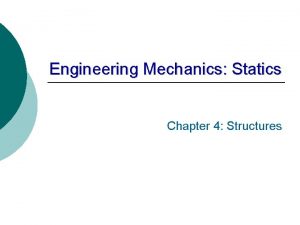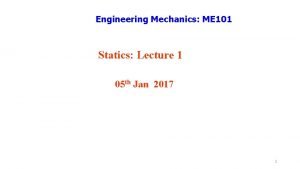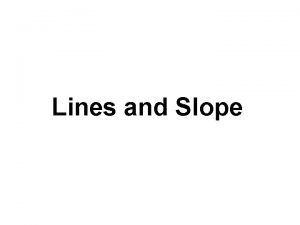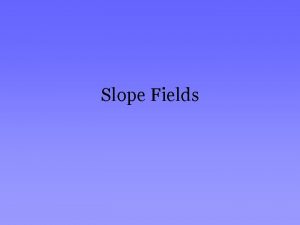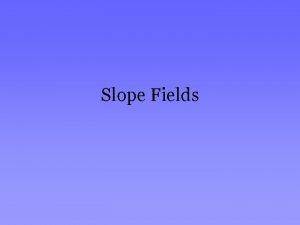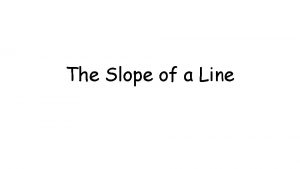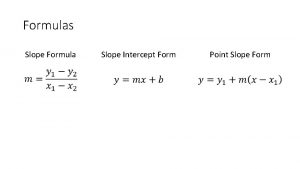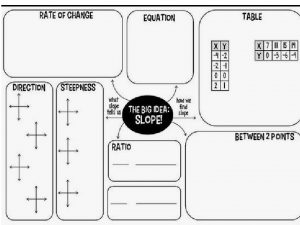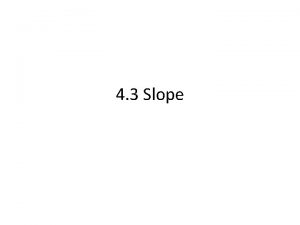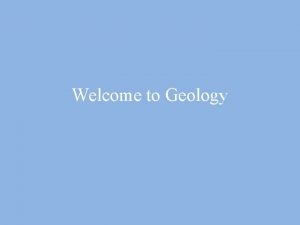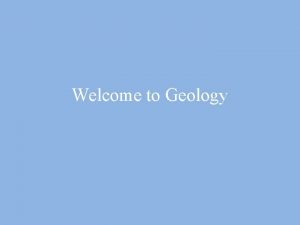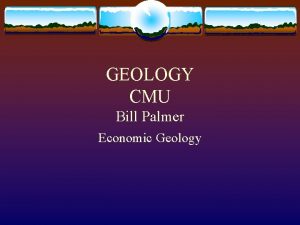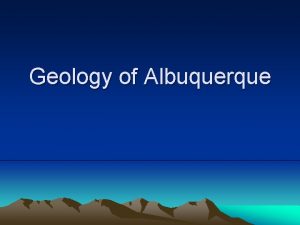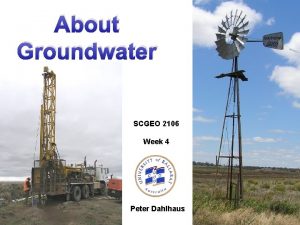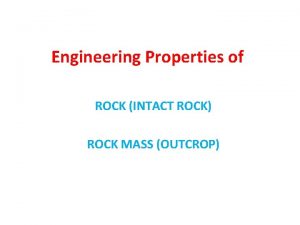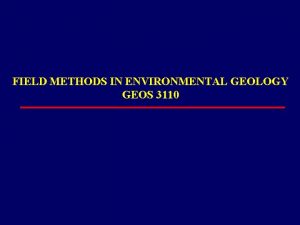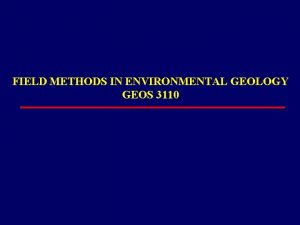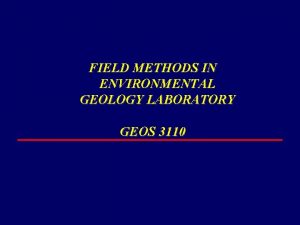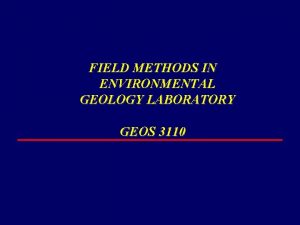SCGEO 3110 Engineering Geology Rock Mechanics Rock slope



























- Slides: 27

SCGEO 3110 – Engineering Geology

Rock Mechanics Rock slope stability Underground mines Blasting Weathering Drilling Ripability Open pit mines Dimension stone Deep drilling (oil & gas) Ancient monuments Mine fill In situ rock stress Rheid flows Durability Dams Excavatability Mine subsidence 5 th ISRM Congress, Melbourne 1983 – Excursion to Thompson Dam (looking at rockslide plane)

Rock substance or rock mass ? ü The rock substance is the rock material itself ü The rock mass is the entire body of fractured rock Rock mechanics is scale-dependent

Rock substance The mechanical behaviour of the rock substance depends on the: ü lithology: e. g. crystalline, foliated, particular, cemented, etc. ü strength of the minerals that make up the rock, e. g. quartz vs mica ü degree of weathering and alteration of the minerals ü micro-fabric: e. g. cleavage planes, micro fractures, etc. ü porosity, degree of saturation and pore water pressures Thin section of basalt Thin section of sandstone Thin section of schist

Rock substance For similar lithologies, the strength and durability of the rock substance is related to the degree of weathering Fresh (F) – no visible signs of weathering: perhaps slight discolouration on joints Slightly Weathered (SW) – Some discolouration of rock and discontinuity surfaces. May be weaker than fresh rock MW SW HW Sandstone wall, Port Arthur, Tas 2010 Moderately Weathered (MW) – Rock may be discoloured but the loss of strength and hardness is not great Highly Weathered (HW) – Rock is entirely discoloured usually showing iron-oxide staining. Porosity can be changed (increased or decreased) and the loss of strength and hardness is considerable Completely Weathered (CW) – all rock material is disintegrated. The original rock fabric is still intact but the rock can disintegrate by gentle agitation in water.

Rock substance Alteration of the minerals changes the strength and mechanical properties of the rock substance, especially where clay minerals are the end result of the chemical alteration Least stable partial alteration of an olivine crystal in dunite to serpentine group minerals (crossed polars) http: //www. ucl. ac. uk/~ucfbrxs/PLM/serp. html Most stable

Rock substance There have been attempts at a Unified Rock Classification System (similar to the Unified Soil Classification System) but none is universally adopted. A unified system that suits all purposes is challenging.

Rock substance An attempt at a Unified Rock Classification System (Williamson & Kuhn, 1988). Degree of Weathering Element A B C D E Micro Fresh State (MFS) Visual Fresh State (VFS) Stained State (STS) Partly Decomposed State (PDS) Completely Decomposed State (CDS) AAAA rating = least design consideration EEEE rating = most design consideration Strength Estimate Element A B C D E Rebound reaction to hammer blow (RQ) Pits with hammer blow (PQ) Dents with hammer blow (DQ) Craters with hammer blow (CQ) Can be remoulded with finger pressure (MBL) Unit Weight Element Planar and Linear Element A B C D E Solid with random breakage (SRB) Solid with preferred breakage (SPB) Latent planes of separation (LPS) Planes of separation in 2 dimensions (2 -D) Planes of separation in 3 dimensions (3 -D) A B C D E Greater than 2. 55 t/m 3 2. 40 – 2. 55 t/m 3 2. 25 – 2. 40 t/m 3 2. 10 – 2. 25 t/m 3 Less than 2. 10 t/m 3

Rock substance Strength testing Unconfined Compressive Strength (UCS) Triaxial Strain measurement Point Load test

Rock substance Strength testing Beam test Brazil tensile test underway (Briony Muller UB Hons 2003) Direct tensile test

Rock substance Durability testing • Slake Durability Index tests • Wetting/drying tests • Freeze/thaw tests • Wearability • Los Angeles Abrasion • Polished Stone Value • Skid resistance tests • Aggregate Crushing Value • Sodium Sulfate Soundness • Magnesium Sulfate Soundness Durability tests are used to determine the rock properties for construction, building cladding, dam walls, roads, concrete aggregate, mining machinery tip wear, etc. Slake durability index test Los Angeles abrasion test

Rock substance Excavability testing Drillability Ripper-tip wear Seismic velocity related to rippability

Rock mass Tessellated Pavement, Eaglehawk Neck, Tasmania

Rock mass The properties of the rock mass take into account the discontinuities in the rock. . . In fact, in most cases, it’s all about the discontinuities. . . They are more important than the rock substance!

Rock mass The description of rock mass is laid out in the Australian Standards and the International Society of Rock Mechanics recommended methods. It is quite specific and follows a rigid set of descriptions. There are notes on the unit web-site which provide the detail Some of the seminal textbooks are also excellent references

Rock mass Description Degree of weathering of the rock mass Fresh (F) – no visible signs of weathering: perhaps slight discolouration on joints Slightly Weathered (SW) – Some discolouration of rock and discontinuity surfaces. Joints may be open <5 mm. Moderately Weathered (MW) – Less than 50% of the rock mass is disintegrated or discoloured. Joints may be filled with clays. Highly Weathered (HW) – More than 50% of the rock mass is decomposed or discoloured. Joints are open and filled with clays. Completely Weathered (CW) – all rock mass is disintegrated. The original structure of the rock mass can still be seen, but the rock behaves as a soil. Devils Gate Dam, Tasmania

F tillite, (Durban, South Africa) MW mudstone, (Ballarat) HW dolerite, (Lewisburg, South Africa) CW granite, (Durban, South Africa)

Rock mass Description HW Basalt, Parwan, Vic MW Rocklands Rhyolite, Wannon, Vic MW Otway Group sandstone, Near Lorne, Vic

Rock mass Description Type of discontinuities ü Joints (usually in sets) ü Fractures (random joints) ü Faults (displacement on fracture) ü Bedding planes ü Non-conformity surfaces

Rock mass Description Geometry of discontinuities ü Number of joint sets ü Joint orientations (dip/dip direction) ü Joint persistence ü Joint spacing, frequency, block size ü Rock Quality Designation (RQD) ü Aperture and filling

Rock mass Description Joint roughness Determines the “locking” of movement along a joint

Rock mass Rock Quality Designation (RQD)

Rock mass Classification There are various rock mass classification schemes in common use: üRock Mass Rating (RMR) üRock Structure Rating (RSR) üQ - System These are mostly used to determine ground support in underground mining and engineered rock slopes

Common Rock Mass Classification systems Rock Mass Rating (RMR) ü UCS ü RQD ü Spacing of discontinuities ü Condition of discontinuities ü Groundwater conditions ü Orientation of discontinuities Rock Structure Rating (RSR) ü Rock type ü Geologic structure ü Rock jointing ü Orientation (w. r. t. drive) ü Joint condition ü Groundwater Q – System ü RQD ü joint set no. (Jn) ü joint roughness no. (Jr) Q = (RQD/Jn) x (Jr/Ja) x Jw/SRF) ü joint alteration no. (Ja) ü joint water reduction factor (Jw) ü stress reduction factor (SRF)

Rock mass classification schemes are used as a “ready reckoner” to determine the ground support - rock anchors, rock bolts, mesh, shotcrete, steel sets, etc. that is required.

The need for ground support depends on the rock mass quality, roof span and time 1 d 30 20 Immediate collapse 50 Roof span (m) 10 1 wk 1 mo 60 1 yr 10 yr 70 40 30 5 Support required 20 50 2 40 1 30 100 ng ati ss R a M k c o R 80 No support required 20 10 -1 60 70 101 102 103 104 Stand-up time (hrs) 105 http: //www. youtube. com/watch? v=e. ICMSgr-x 14 106

Rock Mechanics is a discipline in its own right. To learn about it more thoroughly you would need to take a unit dedicated to it for one or two semesters. Please explore the unit website for more information on this important topic. There is quite a lot of information available and it is useful to those of you who are intending to go into the mining industry or into engineering geology.
 Rock mechanics
Rock mechanics Igneous and metamorphic
Igneous and metamorphic Slope decline and slope retreat
Slope decline and slope retreat Point-slope form definition geometry
Point-slope form definition geometry Slope review classifying slope
Slope review classifying slope Slope review classifying slope
Slope review classifying slope Pluronic pe 10500
Pluronic pe 10500 Cornell cs3110
Cornell cs3110 631-828-3110
631-828-3110 What is the 8-bit unsigned binary result of 5610 − 3110?
What is the 8-bit unsigned binary result of 5610 − 3110? Boletin 3110
Boletin 3110 Rock mechanics and mining sciences
Rock mechanics and mining sciences International journal of rock mechanics and mining sciences
International journal of rock mechanics and mining sciences Engineering mechanics: statics in si units
Engineering mechanics: statics in si units Cone of friction in engineering mechanics
Cone of friction in engineering mechanics Equilibrium engineering mechanics
Equilibrium engineering mechanics Force system in engineering mechanics
Force system in engineering mechanics What is centroid in engineering mechanics
What is centroid in engineering mechanics Centroid in engineering mechanics
Centroid in engineering mechanics Equilibrium of rigid bodies in engineering mechanics
Equilibrium of rigid bodies in engineering mechanics Trusses in engineering mechanics
Trusses in engineering mechanics Particle equilibrium in 2d and 3d engineering mechanics
Particle equilibrium in 2d and 3d engineering mechanics Statics force vectors
Statics force vectors Kinetics of rigid bodies
Kinetics of rigid bodies Virtual work problems in engineering mechanics
Virtual work problems in engineering mechanics Centroid statics
Centroid statics Statics of structures
Statics of structures Me 101 engineering mechanics
Me 101 engineering mechanics


